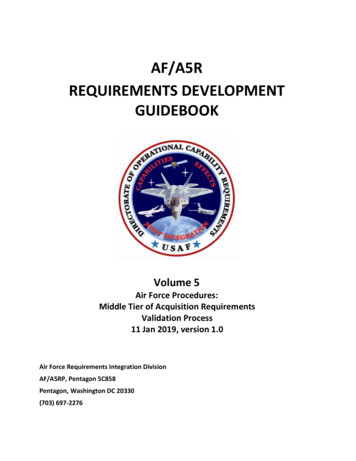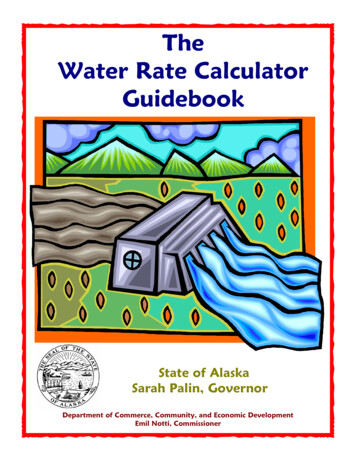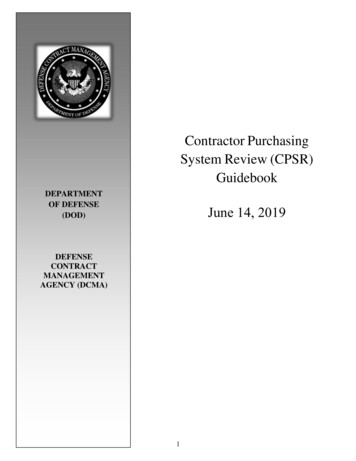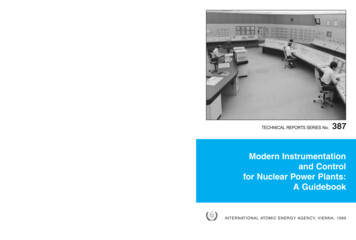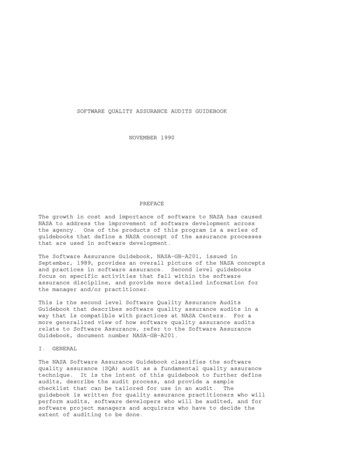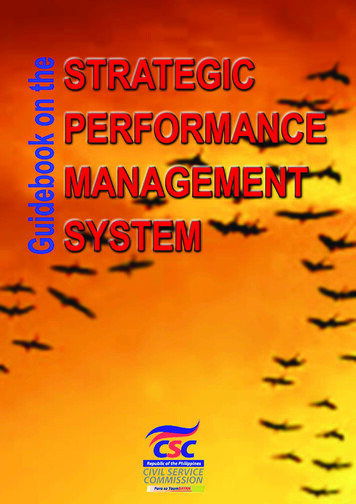
Transcription
Guidebook on theStrategic Performance Management SystemHuman Resource Policies and Standards OfficeCIVIL SERVICE COMMISSION
ForewordIt has been said that a journey begins with asingle step. And as the journey progresses,one has to keep track of one’s gears, one’sdestination, how fast one can get to thejourney’s end.Over the years, the Civil Service Commissionhas been at the forefront of the journeyof reform and transformation of thebureaucracy. While it has logged milestonesand went past crossroads, it has neverlost sight of its goal—that of creating atruly responsive, motivated, and efficientworkforce in government.The CSC continues the journey with yet another tool specifically for humanresource management officers in the public sector. In your hands is theGuidebook on the Strategic Performance Management System (SPMS),a step-by-step guide in establishing the agency SPMS. The Guidebookprovides basic information and competencies needed to set-up the SPMS,including discussions on the system’s cycle: performance planning andcommitment building; monitoring and coaching; performance review andevaluation; and rewarding and development planning. It aims to guideHRMOs in using the system to better identify, assess, and streamlineperformance measurement processes.The Commission has prioritized SPMS among its human resourceinitiatives. CSC hopes that government agencies nationwide would beable to appreciate how the system would help create a work environmentwhere civil servants—from executives to the administrative aides—areable to link individual performance with organizational goals and performto the best of their abilities. And through this Guidebook, the Commissionhopes to stay on course in initiating definitive measures geared towardsupgrading the standards of public sector governanceFrancisco T. Duque III, MD, MScCHAIRMAN
AcknowledgementThe production of this Guidebook would not have been possible withoutthe invaluable support of the Australian Agency for InternationalDevelopment (AusAid) through the Philippine Australia Human Resourceand Organisational Development Facility (PAHRODF).We would also like to acknowledge the contributions of the following: Representatives of the Department of Budget and Management (DBM),Department of the Interior and Local Government (DILG), and TechnologicalUniversity of the Philippines (TUP) for participating in the pre-test ofthe Guidebook. The CSC Public Assistance and Information Office (PAIO) for its technicalinputs in the layout of the Guidebook.iiiii
Table of ContentsForewordAcknowledgementGlossaryMeasuring Performance through the Yearsiiiivii1The Strategic Performance Management System:Building on Past Initiatives3HOW TO ESTABLISH THE SPMS IN YOUR ORGANIZATION7Step 1. Form the Performance Management Team7Step 2. Review the Existing Performance Management System11PERFORMANCE PLANNING AND COMMITMENT15Step 3. Know and Understand Your Agency’s Major Final Outputs17Step 4. Identify the Success Indicators of Each Major Final Output21Step 5. Identify the Performance Goals of Your Office29Step 6. Identify the Performance Goals of the Divisions under Your Office 35Step 7. Identify the Performance Goals of Individuals Under Each Division 39Step 8. Develop the Rating Scale45PERFORMANCE MONITORING AND COACHING59Step 9. Develop the Performance Monitoring & Coaching Tools61Step 10. Develop the Performance Evaluation Tools67PERFORMANCE REVIEW AND EVALUATION73Step 11. Use the Performance Evaluation Tools75PERFORMANCE REWARDING & DEVELOPMENT PLANNING83Step 12. Use the Results of the Performance Evaluation85CRAFTING YOUR AGENCY SPMS GUIDELINES89Tables and ChartsTable 1. SPMS Paradigm Shift3Table 2. SPMS Key Players and their Responsibilities8Table 3. Major Final Outputs of the CSC19Table 4. CSC Scorecard22Table 5. CSC MFOs, Strategic Objectives, Measures,and Success IndicatorsTable 6. Office Level (HRPSO) Success Indicatorsiv2633
Table 7. Regional Office Level (CSCRO) Success Indicators34GlossaryTable 8. Office Level (HRPSO) and Division Level (APCCD)Success Indicators35Table 9. Regional Office Level (CSCRO) and Division Level (PSED)Success Indicators37Table 10. Office Level (HRPSO), Division Level (APCCD), and IndividualLevel (Staff) Success Indicators40Table 11. Regional Office Level (CSCRO), Division Level (PSED), andIndividual Level (Staff) Success IndicatorsMeaningAPCCDAudit and Position Classification and Compensation DivisionARTAAnti-Red Tape ActARTA-RCSAnti-Red Tape Act-Report Card SurveyCARE-HRMContinuing Assistance and Review for ExcellentHuman Resource ManagementCBCertifying BoardCHARMComprehensive Human Resource Management Assistance,Review, and MonitoringCNACollective Negotiation AgreementCSCivil ServiceCSCCivil Service Commission43Table 12. Examples of How to Determine the Dimensions toRate Performance47Table 13. Operationalization of the Rating Scale48CSCAAPCivil Service Commission Agency Accreditation ProgramTable 14. HRPSO Rating Matrix49CSCFOCivil Service Commission Field OfficeCSCROCivil Service Commission Regional OfficeCSE-PPTCareer Service Examination - Paper and Pencil TestCSICivil Service InstituteTable 15. CSCRO Rating Matrix51Table 16. APCCD Rating Matrix52Table 17. PSED Rating Matrix54CSLOCommission Secretariat and Liaison OfficeTable 18. Employee A Rating Matrix55DBMDepartment of Budget and ManagementDOLEDepartment of Labor and EmploymentDPCRDivision Performance Commitment and ReviewEEfficiencyTable 19. Employee B Rating Matrix56Table 20. Employee C Rating Matrix57Table 21. Employee D Rating Matrix58EOExecutive OrderTable 22. Sample Ratings of Accomplishments78ERPOExamination Recruitment and Placement OfficeTable 23. Ratings of Individual Staff under HRPSO79ESDExamination Services DivisionTable 24. HRPSO’S Summary of Ratings (OPCR)80GASGeneral Administration and SupportGOCCGovernment-Owned and Controlled CorporationsHRHuman ResourceChart 1. An Overview of the Performance Management System Cycle11HRDHuman Resource DivisionChart 2. CSC Logical Framework18HRMOHuman Resource Management OfficeChart 3. Link between CSC’s Logical Framework and Scorecard25HR/ODHuman Resource and Organization DevelopmentChart 4. CSC Offices Contributing to Specific MFOs29HRPSOHuman Resource Policies and Standards OfficeIPCRIndividual Performance Commitment and ReviewIRMOIntegrated Records Management OfficeISOInternational Standards OrganizationKRAKey Result AreaLGULocal Government UnitLSDLegal Services DivisionLSPLocal Scholarship ProgramLWDLocal Water DistrictM&EMonitoring and EvaluationMBOManagement by ObjectiveMCMemorandum CircularChart 5. Illustration of CSC Offices at the Central and Regional LevelsContributing to the MFOs31Chart 6. Illustration of One CSC Office and Division at CentralviAbbreviationsand Regional Levels Contributing to MFO32Chart 7. Alignment of OPCR, DPCR, and IPCR68vii
MFOMajor Final OutputMOAMemorandum of AgreementMOREManagement by Objectives and Results EvaluationMSDManagement Services DivisionN/ANot ApplicableNGANational Government AgenciesNPASNew Performance Appraisal SystemOFAMOffice for Financial and Assets ManagementOHRMDOffice for Human Resource Management and DevelopmentOLAOffice for Legal AffairsOPCROffice Performance Commitment and ReviewOPESOffice Performance Evaluation SystemOPIFOrganizational Performance Indicator FrameworkOSMOffice for Strategy ManagementPAIOPublic Assistance and Information OfficePALDPublic Assistance and Liaison DivisionPAPPrograms, Projects, and ActivitiesPERCPerformance Evaluation Review CommitteePESPerformance Evaluation SystemPMSPerformance Management SystemPMS-OPESPerformance Management System-Office PerformanceEvaluation SystemPMTPerformance Management TeamPMUProject Management UnitPRAISEProgram on Awards and Incentives for Service ExcellencePROPersonnel Relations OfficePSEDPolicies and Systems Evaluation DivisionPSSDPersonnel Systems and Standards DivisionPRIME-HRMProgram to Institutionalize Meritocracy and Excellencein Human Resource ManagementQQualityQSQualification StandardsQSSDQualification and Selection Standards DivisionRARepublic ActRBPMSResults-Based Performance Management SystemRORegional OfficeSMARTSpecific, Measurable, Attainable, Realistic, and Time-boundSPEARSpecial Program for Evaluation and Assessment asRequired/RequestedSPMSStrategic Performance Management SystemSTOSupport to OperationsSUCState Universities and CollegesTTimelinessTARDTalent Acquisition and Retention DivisionWIGWildly Important Goal
1999: Revised PES andMeasuring Performance through the Years360-Degree EvaluationMemorandum Circular No. 13, s. 1999 revised the PESand introduced the 360 degree evaluation, a cross ratingAs the central human resource manage-system in which assessment of performance and behaviorment agency of the Philippine bureau-PerformanceEvaluation Systemis constitutionally mandated to adoptmeasures to promote morale, efficiency,integrity, responsiveness, courtesy andpublic accountability among governmentemployees.Through the years, the CSC has implemented several performance evaluationand appraisal systems.The CSC provided simple guidelinesto empower government agenciesThe New Performance Appraisal(NPAS) was based onDrucker’sfeedback from their subordinates, peers, supervisors,and clients. The Revised PES required each governmentThrough Memorandum Circularagency to create a Performance Evaluation ReviewNo. 12, s. 1993, the PerformanceCommittee (PERC) tasked to establish performanceEvaluation(PES)standards. An evaluation of the cross-rating systemsought to establish an objectiverevealed that employees perceived the system to beperformance system. The CSCtoo complex.providedIn 2001, through CSC MC No. 13, s. 2001, Agency HeadsSystemspecificguidelineson setting the mechanics ofto develop their own Performancethe rating system. Similar tothe NPAS and MORE, the PESline was made through Memorandumalso measured the employee’sCircular No. 12, s. 1989. Internally,performance and behavior in thework environment.MORE (Management by ObjectivesNew PerformanceAppraisal SystemPeterAutonomyof Agencies in Developingtheir PerformanceEvaluation Systemthe CSC adopted a system called1978:System1989:Evaluation System (PES). This guide-Below is a brief review of past initiatives:comes from the employees’ self-evaluation as well as1993:cracy, the Civil Service Commission (CSC)were given the discretion to utilize the approved PESor devise a Performance Evaluation System based on acombination of the old PES and the revised performanceevaluation system.2005:Performance ManagementSystem-Office PerformanceEvaluation Systemand Results Evaluation) in whichthe employee’s accomplishments inperformance and behavior are moni-Thetored weekly.by Objectives (MBOs) system.randum Circular No. 2, s. 1978,the NPAS focused on key resultareas (KRAs) along the dimen-System-Office(PMS-OPES)of linking the performance management systemwith national goals as stated in the following: Medium-Term Philippine Development Plan Organizational Performance Indicator/sions of quality, quantity, andFramework (OPIF)timeliness. It measured the em-1963:Systemorganizational goals. It emphasized the importance2005PERFORMANCE MANAGEMENTSYSTEM-OFFICE PERFORMANCEEVALUATION SYSTEMImplemented through Memo-havior in the work environment.ManagementEvaluationsought to align individual performance withManagementployee’s performance and be-PerformancePerformance1999REVISED PES AND 360-DEGREEEVALUATION1993PERFORMANCEEVALUATION SYSTEM Major Final Output (MFO)Performance RatingCSC Memorandum Circular No.6, s. 1963 provided the guidelines in developing a system ofperformance rating that would1963PERFORMANCERATING1978NEW PERFORMANCEAPPRAISAL SYSTEM1989AUTONOMY OF AGENCIESIN DEVELOPING THEIR PESmeasure performance of government employees.
Drawingfromtherationalethat “what gets measured getsTO ILLUSTRATE HOW TOdone,” every hour of workCOMPUTE OPES POINTS:is given 1 OPES point in the243 working days in a year x 8 hours in arating system.day 1,944 working hours in a year.The Strategic Performance Management System:Building on Past InitiativesUsing this as the standard unitThe percentage of non-quantifiableof measure, the PMS-OPESoutputs and activities for Regional/FieldrequiredOffice staff is 30%; while the percentagemented over the years have largely focused only on individual appraisals,agency to create a Measurementof quantifiable outputs is 70%.70% ofwhich were used for personnel actions such as incentives, promotion,Development and Calibration1,944 is 1,360 divided by 2 semesters (toTeam that would determineand separation. However, they have not shown how employee perfor-reflect the two monitoring periods everymance has contributed to or hindered organizational effectiveness.eachgovernmentthe equivalent points of eachmajorfinaloutputortheamount of time it will take anaverage competent employeeto produce a specific output.Under the OPES, targets areThe past performance evaluation and appraisal systems that CSC imple-year) 680 points.To get the target points of the office,To address the gaps and weaknesses found in previous evaluation systems,680 points are multiplied by the numberthe CSC recently introduced the Strategic Performance Managementof staff in the office.System (SPMS) after its pilot test in 2011. The SPMS incorporates theFor a Field Office with 5 staff, thepositive features of past initiatives.estimated on the basis of theminimum OPES points should therefore benumber of OPES points required3,400 pts.Like its predecessor, PMS-OPES, the SPMS seeks to link individualper individual per rating periodThis Field Office can get a rating ofperformance with the agency’s organizational vision, mission, andmultiplied by the number ofOutstanding simply by processing a bigindividualstrategic goals. With some adjustments, it also makes use of existingnumber of appointments and examinationmembersoftheorganizational unit.TheOPEScollectivemeasuresapplications.This Field Office, however,themay still have pending appointments thatofneed to be acted upon. The backlog in thea unit. The smallest unit isperformancework of the Field Office is not consideredthe division.in the rating.performance evaluation and management systems and links performancemanagement with other human resource (HR) systems.However, the SPMS makes a major paradigm shift in the following areas:Table 1. SPMS Paradigm ShiftUnder this system, an OPESReference Table was created.Belowarethegovernmentissuances related to the PMS-OPES: Memorandum Circular No. 7, s. 2007 called for the installation of PerformanceManagement System in the Civil Service. Republic Act 9485 or Anti-Red Tape Act (ARTA) required government agenciesto reengineer their systems and procedures and develop their Citizen’s Charter.Performance managementFocusActivities and inputsOutputs and outcomesIndicatorsPerformance indicators (e.g.number of appointmentsprocessed)Success indicators (e.g.response time)PerformancealignmentFocus on individual(competition)Align individual to office/organization (teamworkand collaboration)Role of supervisor Evaluator ToPerformance evaluationevaluation system based on objectively-measured performance outputs.performance outputs, the process proved too tedious and overly activity-oriented.FromPerspective Administrative Order 241, Section 5 mandated agencies to institute a performanceAlthough the PMS-OPES sought to create a system with objectively-measuredPARADIGM SHIFTAREACoach and mentor
The government issuances related to the SPMS are the following: Senate and House of Representatives Joint Resolution No. 4 authorizedthe President of the Philippines to modify the compensation and positionclassification system of civilian personnel and the base pay schedule ofmilitary and uniformed personnel in the government. Administrative Order No. 25, s. 2011 created an inter-agency taskforce on the harmonization of national government performancemonitoring, information, and reporting systems. This inter-agency taskforce developed the Results-Based Performance Management System(RBPMS) that established a common set of performance scorecard andharmonized national government performance monitoring, information,and reporting systems. CSC Memorandum Circular No. 6, s. 2012 provided guidelines in theestablishment and implementation of agency Strategic PerformanceManagement System. Joint CSC-Department of Budget and Management (DBM) Joint CircularNo. 1, s. 2012 provided the rules and regulations on the grant of stepincrements due to meritorious performance and length of service. Executive Order No. 80, s. 2012 directed the adoption of a performancebased incentive system for government employees.3. Team approach to performance management. Accountabilities andindividual roles in the achievement of organizational goals are clearlydefined to facilitate collective goal setting and performance rating. Theindividual’s work plan or commitment and rating form is linked to thedivision, unit, and office work plan or commitment and rating form toclearly establish the connection between organizational and employeeperformance.4. User-friendly. The suggested forms for organizational and individualcommitments and performance are similar and easy to complete. Theoffice, division, and individual major final outputs and success indicatorsare aligned to cascade organizational goals to individual employees andharmonize organizational and staff performance ratings.5. Information system that supports monitoring and evaluation. TheSPMS promotes the establishment of monitoring and evaluation(M&E) and information systems that facilitate the linkage betweenorganizational and employee performance and generate timely,accurate, and reliable information that can be used to track performance,report accomplishments, improve programs, and be the basis for policydecision-making.6. Communication Plan. Establishing the SPMS in the organizationmust be accompanied by an orientation program for agency officials andemployees to promote awareness and interest on the system and generateappreciation for the SPMS as a management tool to engage officials andBasic Elements of the SPMS:employees as partners in the achievement of organizational goals.1. Goal aligned to agency mandate and organizational edtonationaldevelopment plans, agency mandate, vision, mission, and strategicpriorities, and/or organizational performance indicator framework.Predetermined standards are integrated into the success indicators asorganizational objectives are cascaded down to the operational level.2. Outputs/outcomes-based. The SPMS focuses on the major final outputs(MFOs) that contribute to the realization of the organization’s mandate,vision, mission, strategic priorities, outputs, and outcomes.
Step 1. Form the Performance Management TeamFORM THE PERFORMANCEMANAGEMENT TEAMHow to Establish the SPMS in Your OrganizationThe Performance Management Team (PMT) will spearhead theestablishment of the SPMS in your organization. The PMT shall becomposed of the following:1. Executive Official designated as Chairperson2. Highest Human Resource Management Officer3. Highest Human Resource Development Officer112344. Highest Planning Officer5. Highest Finance Officer6. President of the accredited employee associationThe Planning Office will function as the Secretariat.When establishing the SPMS, it is important to have the following keyplayers who will assume the responsibilities listed in Table 2:56789101112
Step 1. Form the Performance Management TeamStep 1. Form the Performance Management TeamTable 2. SPMS Key Players and their ResponsibilitiesKEY PLAYERSSPMS Champion12RESPONSIBILITIES Together with the PMT, the SPMS Champion is responsible and accountable forthe establishment and implementation of the SPMS.Head of Office Submits quarterly accomplishment report. Approves office performance commitment and rating. Does initial assessment of office’s performance. Assesses performance of offices. Determines final assessment of individual employees’ performance level. Sets consultation meetings with all Heads of Offices to discuss the officeperformance commitment and rating system and tools. Informs employees of the final rating and identifies necessary interventions toemployees. Ensures that office performance management targets, measures, and budget arealigned with those of goals of the agency.4 Recommends approval of the office performance and rating system and tools.5 Identifies potential top performers for awards. Provides written notice to subordinates who obtain Unsatisfactory or Poor rating.Division Chief Monitors closely the status of performance of subordinates. Assesses individual employees’ performance. Adopts its own internal rules, procedures, and strategies to carry out its responsibilities. Recommends developmental interventions. Functions as the PMT Secretariat. Monitors submission of Office Performance Commitment and Rating Form(OPCR) and schedule the review and evaluation by the PMT. Assumes joint responsibility with the Head of Office in attaining performance targets. Rationalizes distribution of targets and tasks. Acts as appeals body and final arbiter.Planning Office Assumes primary responsibility for performance management in his/her office. Reviews and approves individual performance commitment and rating form. Determines agency target setting period.PMTRESPONSIBILITIES Conducts strategic planning session with supervisors and staff. Sets agency performance goals/objectives and performance measures.36KEY PLAYERSIndividualEmployees Act as partners of management and co-employees in meeting organizationalperformance goals.11234567 Consolidates, reviews, validates, and evaluates the initial performanceassessment based on accomplishments reported against success indicators andbudget against actual expenses.78 Conducts an agency performance planning and review conference annually.891011 Provides each office with the final office assessment as basis in the assessmentof individual employees.Human ResourceManagementOffice (HRMO) Monitors submission of Individual Performance Commitment and Rating (IPCR)Form. Reviews the summary list of individual performance rating. Provides analytical data on retention, skill/competency gaps, and talentdevelopment plan. Coordinates developmental interventions that will form part of the HR Plan.lIf you follow Step 1, you should beable to identify the members of your PMTand draft an office order mandatingthe composition of the PMT.910111212
Step 2. Review the Existing Performance Management SystemREVIEW THE EXISTINGPERFORMANCE MANAGEMENT SYSTEMOnce formed, the first thing that the PMT does is to review theagency’s existing performance management system (PMS) and makenecessary modifications so that it is aligned with the SPMS guidelinesissued through Memorandum Circular No. 6, s. 2012.Chart 1. An Overview of the Performance Management System Cycle1234Stage 4.PerformanceRewarding &DevelopmentPlanningStage 3.PerformanceReview &Evaluation56PMSCYCLEStage 2.PerformanceMonitoring& CoachingStage 1.PerformancePlanning &Commitment7891011121011
Step 2. Review the Existing Performance Management SystemStep 2. Review the Existing Performance Management SystemThe SPMS follows the same four-stage PMS cycle that underscores thePerformance Review and Evaluationimportance of performance management:is done at regular intervals toandassess both the performance ofCoaching is done regularly duringthe individual and his/her office.the performance period by the HeadsThe suggested time periods forof Agency, Planning Office, DivisionPerformance Review and EvaluationPerformance Rewarding and Development Planningand Office Heads, and the individual.are the first week of July and the firstis based on the results of the performance review andThe focus is creating an enablingweek of January the following year.evaluation when appropriate developmental interven-PerformancePerformance Planning and Commitment is done prior1234to the start of the performance period where heads ofStage 1offices meet with the supervisors and staff and agree onthe outputs that should be accomplished based on thegoals and objectives of the organization. The suggestedtime for Performance Planning and Commitment is thelast quarter of the preceding year.environmentfollowing questions: Does your SPMS calendar show that officials andtoimproveteamThesuggestedtimeWhen reviewing Stage 4, ask yourself thequestions:following questions: Are office accomplishments Is there a mechanism for the Head of Office andassessed against the successsupervisors to discuss assessment results with theindicators and the allottedindividual employee at the end of the rating period?When reviewing Stage 2,budget against the actual Is there a provision to draw up a Professionalask yourself the followingexpenses as indicated in the6Development Plan to improve or correct performancequestions:Performance Commitment andof employees with Unsatisfactory or Poor7 Are feedback sessions to discussRating Forms and provided inperformance rating?performance of offices, officials,your Agency Guidelines? Are recommendations for developmentaland employees provided in your Does your SPMS calendarinterventions indicated in the PerformanceAgency Guidelines and scheduledschedule and conduct theCommitment and Rating Form?in your SPMS calendar?Annual Agency Performance Is there a provision on your Agency Guidelines to Are interventions given to thoseReview Conference?link the SPMS with your Agency Human Resourcewho are behind work targets? Is Is individual employeeDevelopment Plan?space provided in the Employeeperformance assessed based on Is there a provision in your Agency Guidelines toFeedback Form for recommendedthe commitments made at thetie up the performance management system withinterventions?start of the rating period?agency rewards and incentives for top performing Is there a form or logbook to Does your agency rating scaleindividuals, units, and offices?record critical incidents, schedulefall within the range prescribed Are the results of the performance evaluationof coaching, and the action plan?in Memorandum Circular No. 13,used as inputs to the Agency HR Plan and rewardss. 1999 - Revised Policies onand incentives? Does your SPMS calendar allot time for the PMTto review and make recommendations on the Does your SPMS calendar indicate the period forHeads of Agency and Offices to approve the officeand individual performance commitments?849PMS1011121213CYCLE2When reviewing Stage 3,Stage4ask yourself the followingStage 2employees are required to submit their commitmentsperformance commitments?suggested time periods for Performance Rewarding andfirst week of January the following year.and Coaching are January to June andJuly to December.tions shall be made available to specific employees. TheDevelopment Planning are the first week of July and theperiods for Performance Monitoringprior to the start of the rating period?5Stage 3performance and develop individualpotentials.When reviewing Stage 1, ask yourself theMonitoringthe PES?12345678910111213
Step 2. Review the Existing Performance Management System123456Steps 3 to 8are all subsumedunder the first stageof the PMS cycle Performance Planningand Commitment.78910111214lIf you follow Step 2, you shoiuld be ableto identify the gaps and PMS areas formodification and enhancement.PerformancePlanning &Commitment
Step 3. Know and Understand Your Agency’s Major Final OutputsKNOW AND UNDERSTAND YOUR AGENCY’SMAJOR FINAL OUTPUTSThe SPMS links staff performance with organizational performance. Assuch, it is important to understand your organization’s mandate andstrategic priorities. During the period of performance planning andcommitment, the first thing to do is to understand your agency’s MajorFinal Outputs.Major Final Outputs refer to the goods and servicesthat your agency is mandated to deliver to externalclients through the implementation of programs,projects, and activities (PAPs).Where you can find the MFOs or strategicpriorities of your agency: The Agency Logical Framework/Organizational PerformanceIndicator Framework (OPIF) Book of Outputs is the main sourcedocument for your organization’s MFOs. This is published by theDepartment of Budget and Management.If your agency does not have a written Logical Framework/OPIFBook of Outputs, the other possible sources of information are thefollowing documents:For National Government Agencies (NGAs), State Universities and Colleges(SUCs) and Government-owned and Controlled Corporations (GOCCs): Philippine Development Plan Agency Charter Agency Strategic Plan/Road Map ScorecardFor Local Government Units (LGUs): Philippine Development Plan Local Government Code Local Development Plan Road Map Strategic Plan Scorecard12345678910111217
Step 3. Know and Understand Your Agency’s Major Final OutputsStep 3. Know and Understand Your Agency’s Major Final OutputsEXAMPLES OF MFOs FOUND IN THE LOGICAL FRAMEWORKCSC’s five Major Final Outputs:Chart 2. CSC Logical Framework12SOCIETAL GOAL56Table 3. Major Final Outputs of the CSCHuman ResourceDevelopment TowardPoverty AlleviationMAJOR FINAL OUTPUTSMFO 1: Legal ServicesMFO 2: Examinations and AppointmentsSECTORAL GOALORGANIZATIONALOUTCOMESGoodGovernanceImproved PublicService Delivery34910111218MFO 3: Personnel Policies and Standards ServicesMFO 4: Human Resource Development ServicesMFO 5: Personnel Discipline and Accountability Enhancement ServicesMerit & RewardsSystem in the Civil ServiceStrengthened andPublic Accountabilityof Civil Servants PromotedMFOs are delivered by core business processes of operating offices/units.However, offices/units that do not directly deliver goods and servicesto external clients contribute to the delivery of the agency’s MFOsthrough Support to Operations (STO) or General Administration a
The Strategic Performance Management System: Building on Past Initiatives 3 HOW TO ESTABLISH THE SPMS IN YOUR ORGANIZATION 7 Step 1. Form the Performance Management Team 7 Step 2. Review the Existing Performance Management System 11 PERFORMANCE PLANNING AND COMMITMENT 15 Step 3.


